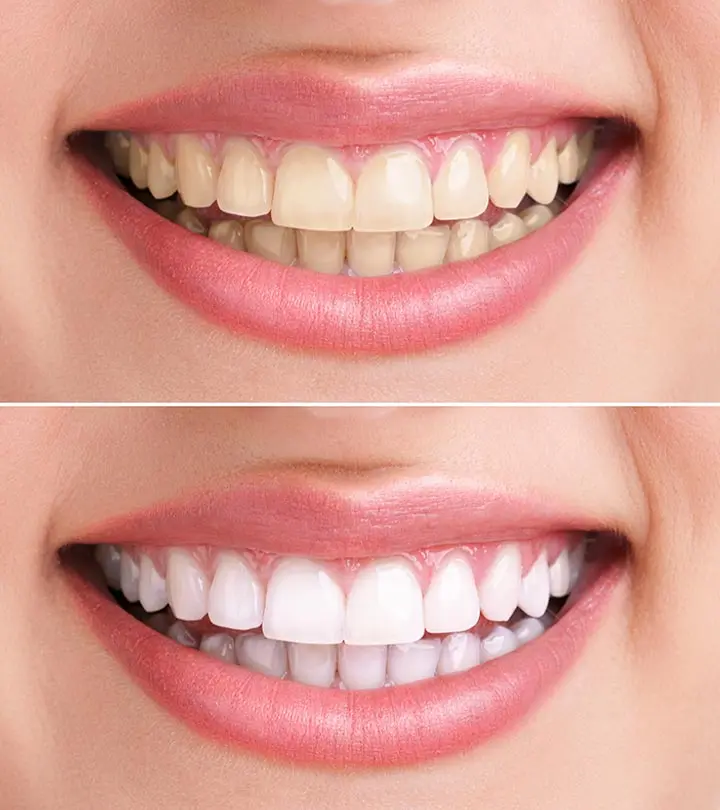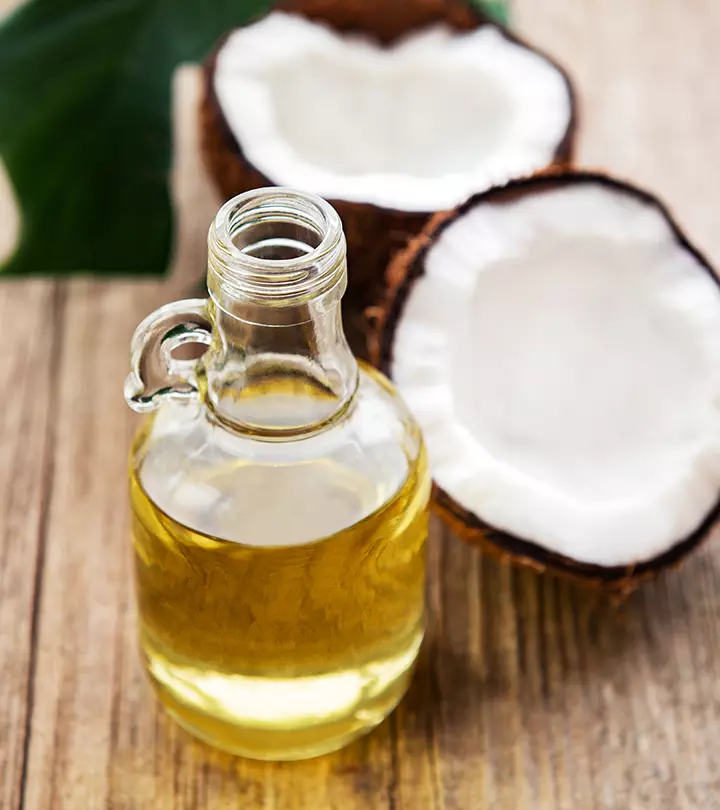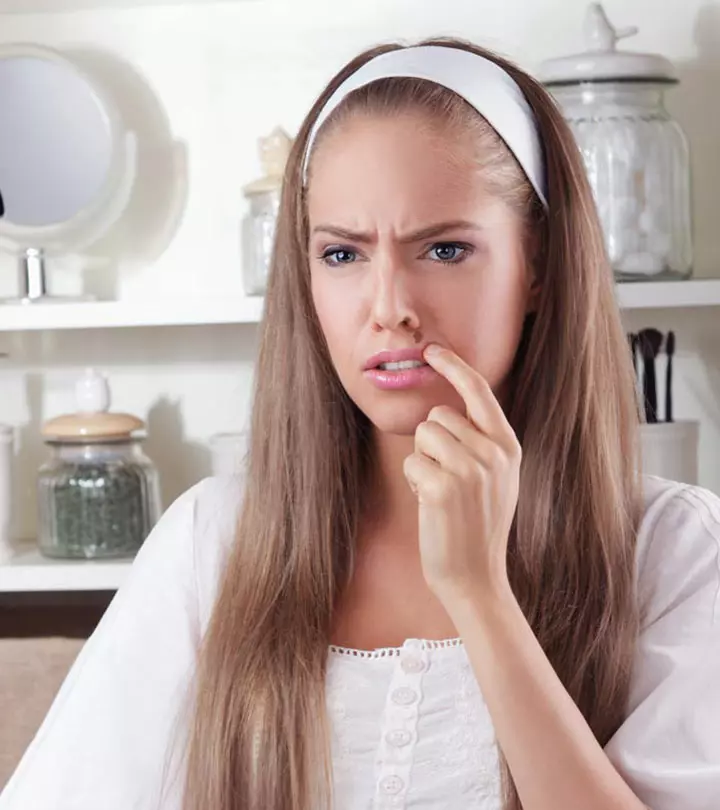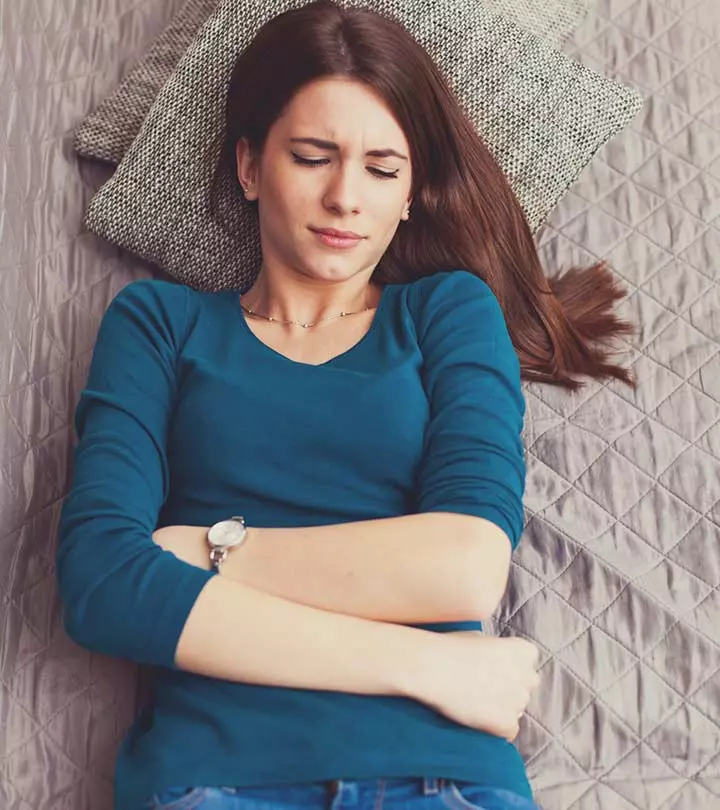7 Effective Ways To Use Baking Soda For Teeth Whitening
Use the right proportions not only while baking cakes but also to smile brighter than ever!

Image: iStock
Eating highly acidic food, drinking alcoholic beverages, and smoking can lead to discoloration of your teeth.
While most people opt for dental treatments like power bleaching, LED teeth whitening devices and whitening toothpastes, you can try natural ingredients such as baking soda to whiten your teeth. Baking soda contains chemical compounds that effectively remove the stains from your teeth. Want to know how to use baking soda to whiten teeth? Scroll down to get detailed info!
 Fun Fact
Fun FactIn This Article
Does Baking Soda Whiten Teeth?
Yes, it does. Baking soda can be a dental manager as it helps keep your teeth white. The chemical composition of baking soda (sodium bicarbonate) makes it alkaline. It neutralizes acids in the mouth, making it mildly abrasive. This, in turn, helps remove stains from your teeth without the use of any chemicals (1). Thus, baking soda is a cost-effective alternative to professional whitening treatments. In fact, many toothpastes and teeth whitening products use baking soda as one of the main ingredients.
A study published in BDJ Open aimed to test the effectiveness of toothpaste containing sodium bicarbonate (baking soda) in removing dental plaque. After a single, timed brushing, the amount of plaque removed with baking soda-containing paste was much higher than with a non-baking soda paste, making it worth exploring the benefits and effectiveness of baking soda in dental hygiene and health.

Effect Of Baking Soda On Teeth
Source: A randomised controlled trial to evaluate the plaque removal efficacy of sodium bicarbonate dentifrices in a single brushing clinical modelLet us now look at the different ways in which you can use baking soda for teeth and brighten your smile almost instantly.
Key Takeaways
- Brushing your teeth with toothpaste containing fluoride after mixing it with baking soda may prevent tooth decay.
- Coconut oil may aid in removing plaque as it has anti-plaque properties.
- Baking soda and salt may help remove stains from your teeth.
- Avoid using baking soda in the abrasive form to prevent enamel damage.
7 Ways To Use Baking Soda To Whiten Teeth
1. Baking Soda And Water

Using baking soda alone with plain water can help in whitening your teeth and removing the plaque build-up. Several studies have concluded that baking soda-based oral products have a significant effect on plaque removal (2), (3).
You Will Need
- 1 teaspoon of baking soda
- 1-2 teaspoons of plain water
What You Have To Do
- Add enough water to a teaspoon of baking soda to form a paste.
- Take this paste on your toothbrush and apply it all over your teeth. Let the mixture work on your teeth for at least a minute.
- Rinse your mouth with water.
How Often You Should Do This
Do this daily for at least a week.
2. Coconut Oil And Baking Soda

Coconut oil is widely used for its oral benefits. It contains medium-chain fatty acids that have antimicrobial properties, which help in getting rid of oral microbes (4). Coconut oil also exhibits anti-plaque activities, which help in getting rid of plaque build-up that makes your teeth dull and yellowish (5).
You Will Need
- 1 tablespoon of coconut oil
- 1 tablespoon of baking soda
What You Have To Do
- Mix a tablespoon each of coconut oil and baking soda.
- Use this mixture to brush your teeth gently for at least 2 minutes.
How Often You Should Do This
Do this 2 to 3 times a week.
3. Baking Soda And Salt
In addition to being a natural antiseptic, salt also has antimicrobial properties (6). It not only helps eliminate oral microbes and plaque but also acts as a mild abrasive and removes stains from your teeth (7).
You Will Need
- 1 1/2 teaspoons of baking soda
- 1/2 teaspoon of rock salt
What You Have To Do
- Mix baking soda with salt.
- Take a little of this mixture on your finger and rub it all over your teeth.
- Allow it to work on your teeth for 2-3 minutes.
- Rinse your mouth with water.
How Often You Should Do This
This remedy can give you instant results. But you can continue using it for at least a week.
4. Hydrogen Peroxide And Baking Soda

Using hydrogen peroxide for teeth whitening has been done for decades. It is another popular bleaching agent that is widely used in various mouthwashes and toothpastes. It not only brightens your teeth but is also effective against oral microbes and plaque. The combination of hydrogen peroxide and baking soda releases free radicals that may help in breaking up the plaque build-up and remove stains from your teeth (8), (9).
You Will Need
- 1 tablespoon of baking soda
- 2 tablespoons of 3% hydrogen peroxide
What You Have To Do
- Combine a tablespoon of baking soda with two tablespoons of 3% hydrogen peroxide.
- Use this paste to brush your teeth gently for 1 to 2 minutes.
- Rinse your mouth thoroughly.
How Often You Should Do This
This remedy gives you instant results and can be followed twice a week for a month.
5. Toothpaste And Baking Soda

It is recommended that you brush your teeth daily with a fluoride-based toothpaste to get rid of plaque, avoid cavities and tooth decay. While the fluoride in the toothpaste protects your teeth from cavities and helps in removing stains, the abrasive nature of baking soda can help in polishing your teeth and make them whiter (10).
You Will Need
- 1/2 teaspoon of baking soda
- 1 teaspoon of toothpaste
What You Have To Do
- Mix baking soda with toothpaste.
- Use this paste to gently brush your teeth for 2 to 3 minutes.
- Rinse your mouth with water.
How Often You Should Do This
Do this twice a week for at least a month.
6. Baking Soda And Foil
Baking soda and toothpaste are quite effective in whitening the teeth and removing stains. Using an aluminum foil to wrap this mixture and leaving it on helps in breaking down the stain molecules on your teeth and gives you brighter and whiter teeth. However, there are no scientific studies to prove these effects.
You Will Need
- 1/2 teaspoon of baking soda
- 1 teaspoon of toothpaste
- A small piece of aluminum foil
What You Have To Do
- Mix baking soda with toothpaste.
- Spread this paste over two wide strips of aluminum foil.
- Wrap the strips around your upper and lower teeth and leave them on for an hour.
- Remove the foil after an hour and brush your teeth normally.
How Often You Should Do This
Do this once a week.
7. Baking Soda And Lemon Juice
Baking soda and lemon juice make quite the teeth whitening pair. Both ingredients may help remove or lighten stains to whiten your teeth. However, use this remedy sparingly, as both are abrasive and may damage the top layer of your teeth. research found that prolonged exposure to lemon juice could cause enamel erosion and severe damage to the teeth (11).
You Will Need
- A pinch of baking soda
- 2-3 drops of lemon juice
What You Have To Do
- Put a pinch of baking soda on your toothbrush, followed by 2-3 drops of lemon juice.
- Gently massage your teeth with it for about 2 minutes and rinse well.
How Often You Should Do This
Do this once in 2-3 months.
Points To Keep In Mind

- During this process of teeth whitening with baking soda, do not brush your gums as it may cause irritation and bleeding.
- If you have periodontal disease, consult your doctor before using baking soda to whiten your teeth.
- Always use baking soda in the diluted form as its abrasive nature can cause damage to the enamel.
- Avoid using baking soda if you are wearing a permanent retainer as it can affect its integrity.
- Do not continue using baking soda on a long-term basis as it can damage your enamel and cause your teeth to become excessively sensitive.
 Quick Tip
Quick TipInfographic: 4 Ways To Whiten Teeth With Baking Soda
Baking soda has mild abrasive properties that help remove plaque and stains from the teeth effectively, making them appear brighter. While there are many ways to use baking soda to whiten teeth, we have listed the most effective ones in the infographic below. Check it out to know more.

Illustration: StyleCraze Design Team
You can use baking soda to whiten your teeth as it acts as a mild abrasive. Foods or beverages rich in acids may discolor your teeth. The chemicals present in baking soda help remove these stains effectively. You can just use baking soda or it can be coupled with other agents like salt, hydrogen peroxide, or add it to your toothpaste. Make sure you avoid applying this paste on your gums and dilute it appropriately. Additionally, maintain proper oral hygiene for healthy gums and teeth. Should the problem persist, be sure to consult your dentist.
Frequently Asked Questions
Does it damage your teeth to brush with baking soda?
Baking soda is a milder abrasive than some other agents used for teeth whitening and does not cause damage to the teeth if used cautiously and infrequently. However, vigorously brushing with baking soda may damage tooth enamel over time.
Can I brush my teeth with baking soda every day?
Yes, you can, but baking soda cannot replace fluoride, the component in most toothpastes that strengthens tooth enamel and prevents decay and cavities. Therefore it is not recommended as a substitute for regular brushing.
Is it safe to gargle baking soda every day?
It is not safe to gargle with baking soda every day as it can erode enamel.
Can using baking soda to whiten teeth also help freshen breath?
While baking soda can help whiten teeth, it may not help in freshening your breath.
Illustration: Ways To Use Baking Soda To Whiten Your Teeth Naturally

Image: Stable Diffusion/StyleCraze Design Team
References
Articles on StyleCraze are backed by verified information from peer-reviewed and academic research papers, reputed organizations, research institutions, and medical associations to ensure accuracy and relevance. Read our editorial policy to learn more.
- Cees Valkenburg et al. “The efficacy of baking soda dentifrice in controlling plaque and gingivitis: A systematic review.” Int J Dent Hyg. 2019 Mar 6;17(2):99–116.
https://pmc.ncbi.nlm.nih.gov/articles/PMC6850485/ - Ghassemi, Annahita et al. “A four-week clinical study to evaluate and compare the effectiveness of a baking soda dentifrice and an antimicrobial dentifrice in reducing plaque.” The Journal of clinical dentistry vol. 19,4 (2008): 120-6.
https://pubmed.ncbi.nlm.nih.gov/19278080 - Putt, Mark S et al. “Enhancement of plaque removal efficacy by tooth brushing with baking soda dentifrices: results of five clinical studies.” The Journal of clinical dentistry vol. 19,4 (2008): 111-9.
https://pubmed.ncbi.nlm.nih.gov/19278079 - Peedikayil, Faizal C et al. “Comparison of antibacterial efficacy of coconut oil and chlorhexidine on Streptococcus mutans: An in vivo study.” Journal of International Society of Preventive & Community Dentistry vol. 6,5 (2016): 447-452.
https://www.ncbi.nlm.nih.gov/pmc/articles/PMC5109859/ - Peedikayil, Faizal C et al. “Effect of coconut oil in plaque related gingivitis – A preliminary report.” Nigerian medical journal : journal of the Nigeria Medical Association vol. 56,2 (2015): 143-7.
https://www.ncbi.nlm.nih.gov/pmc/articles/PMC4382606/ - Wijnker, J J et al. “Antimicrobial properties of salt (NaCl) used for the preservation of natural casings.” Food microbiology vol. 23,7 (2006): 657-62.
https://pubmed.ncbi.nlm.nih.gov/16943065// - Kalliath, Chacko et al. “Comparison between the effect of commercially available chemical teeth whitening paste and teeth whitening paste containing ingredients of herbal origin on human enamel.” Ayu vol. 39,2 (2018): 113-117.
https://www.ncbi.nlm.nih.gov/pmc/articles/PMC6369603/ - Kleber, C J et al. “In vitro tooth whitening by a sodium bicarbonate/peroxide dentifrice.” The Journal of clinical dentistry vol. 9,1 (1998): 16-21.
https://pubmed.ncbi.nlm.nih.gov/9835828 - Ahrari, Farzaneh et al. “Effectiveness of sodium bicarbonate combined with hydrogen peroxide and CPP-ACPF in whitening and microhardness of enamel.” Journal of clinical and experimental dentistry vol. 9,3 e344-e350.
https://www.ncbi.nlm.nih.gov/pmc/articles/PMC5347279/ - Thong, S et al. “Enhancement of plaque removal by baking soda toothpastes from less accessible areas in the dentition.” The Journal of clinical dentistry vol. 22,5 (2011): 171-8.
https://pubmed.ncbi.nlm.nih.gov/22403983 - Bassiouny, Mohamed A et al. “Topographic and radiographic profile assessment of dental erosion. Part II: effect of citrus fruit juices on human dentition.” General dentistry vol. 56,2 (2008): 136-43.
https://pubmed.ncbi.nlm.nih.gov/18348369/
Read full bio of Dr. Thomas Connelly
Read full bio of Shaheen Naser
Read full bio of Arshiya Syeda
Read full bio of Moksha Gandhi


























Community Experiences
Join the conversation and become a part of our empowering community! Share your stories, experiences, and insights to connect with other beauty, lifestyle, and health enthusiasts.